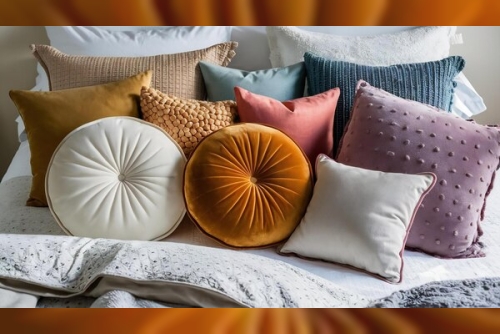There is more to colour than just pretty pigments and interesting hues. Just like words hold certain meanings, so do colours. Their meanings can impact one’s everyday life and affect their mood, which is why the psychology of colour is so important when deciding on interior design. Whether we’re talking about accent walls, carpets or cushions, the colours we attribute to the things around us can and will impact our mood. If you were considering enriching your house with decorative cushions wool carpets or glass vases, colour is one aspect you must not neglect in your pursuit.
Short History of ColoursColours have long been a part of human life. From their earliest stages, as long as 40,000 years ago, to today, colours continue to paint our world. It may have all started with just few fainted hues off black and red smeared upon cave walls, but the spectrum of colours we have today is nothing short of incredible. Scientists believe there are over 10 million colours that are able to be seen by the human eye. One can only imagine how many other ones out there in the universe.
Traditionally, colours were initially derived from natural elements, such as lapis lazuli for blue and the colour purple from sea snails. The invention of synthetic dyes revolutionized the textile industry, bringing to the masses what was otherwise affordable only to the rich. This also led to the creation of many other colours that we can now enjoy.
Today, our access to colour is close to unlimited, regardless of whether we’re talking about paints, textiles, materials or digital elements. Their meaning, however, goes far beyond what the human eye meets and colours pose a much greater meaning than one can imagine. The calming and relaxing or, on the other hand, revitalizing and refreshing properties the colours bring can impact one’s mood and influence their everyday life. As synthetic dyes made it easier for us to surround ourselves with colours, it is important to know their meaning and chose accordingly the hues we choose for the walls, carpets, cushions and other household elements.
Colours and Their MeaningDid you know that certain colours can evoke certain emotions? Read more to find what some of the most world-wide used colours mean and what feelings they can induce:
Red is believed to be the strongest colour among the warm ones, which makes it a rather vibrant colour to use in design. Symbolizing passion, excitement and energy, red can often turn a blank space into a stimulating and energizing one, with a focus on attention-grabbing. This particularity makes it the best colour to use in decorative pieces, such as cushions, vases and curtains.Blue: the colour blue is often associated with an ambivalent meaning. Symbolizing calmness and peace, as well as coldness and unfriendliness, the colour is one a of kind due to this particular characteristic. This colour is best used in stress-inducing spaces, such as cabinets and offices, as they are known to have a positive effect on the mind and body. It can reduce the pulse and blood pressure and also increase concentration. Used in a dental office or therapy office, it can be the best colour for your decorative cushions so that clients have something to hold on to during sessions.Yellow is the colour of happiness. Often associated with joy and optimism, this colour can increase concentration and trigger a sense of alertness. Yellow cushions, vases, table clothes or paintings can brighten up a space, making it more inviting, which makes them a suitable option for living-rooms.Orange shares the beneficial aspects of yellow and is furthermore known for improving one’s appetite. Often associated with the sun and exotic fruits, orange is a colour that is often used in the treatment for depression, which makes it a great colour for spaces that invoke stress and sadness. Depending on their diet, one might want to use it for their chair cushions and plates in the kitchen or as an accent wall in their office.Green has long been nicknamed “the colour of nature” and very rightfully so. One of the most appreciated properties of green is that of reducing insomnia, which makes it the perfect colour for your bedroom. Other “healing” properties include the stimulation of endocrine glands and the reducing of pressure. Green might be the best colour for decorative cushions and pillows, as its sleep-inducing properties can help with insomnia.Best Colours for Cushions, Carpets and BlanketsBased on the aforementioned analysis, we can conclude that each of these colours represent a suitable choice for the textiles in your home or office. Depending on your goal with the room, you might want to choose the colour scheme in accordance with your objective. Green cushions are best for sleeping areas, while red accents are suitable in those places you want to attract attention to. Orange might be the best option for your kitchen, if you struggle with boosting your appetite, but it might not be the best if you’re undergoing a dietary plan. Blue, as seen before, can either invoke calm or cold, thus, depending on the space, it can either be an oasis of peace or a cave of solitude.
Decorative Cushions from AustraliaEach country has that one (or many) thing they excel at. Australia is associated in pop culture with kangaroos and vegemite, while, some might appreciate it for its vast biodiversity and cultural and natural landscapes such as the Great Barrier Reef or the Sydney Opera House. Not many people know, however, that Australia has a great and long-lasting legacy in the field of textiles. For example, did you know that Australia is the world’s largest producer of Merino wool? If not, you are missing out on one of the softest wools in the world. But the country’s legacy does not end with Merino wool. Natural fabrics are very much appreciated and these fabrics can elevate your home. Decorative cushions from Australia are often made out of natural materials, including linen, which give your home that clean, effortless and minimalistic look that has been trending for so long.








 Rent A Cozy Fully Furnished Two Room Apartment in Bashundhara R/A.
Rent A Cozy Fully Furnished Two Room Apartment in Bashundhara R/A.



